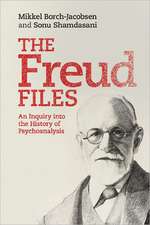Working With Difficult Patients: From Neurosis to Psychosis
Autor Franco De Masien Limba Engleză Paperback – 14 apr 2015
Preț: 359.11 lei
Preț vechi: 378.01 lei
-5% Nou
Puncte Express: 539
Preț estimativ în valută:
68.72€ • 71.66$ • 57.12£
68.72€ • 71.66$ • 57.12£
Carte tipărită la comandă
Livrare economică 20 martie-03 aprilie
Preluare comenzi: 021 569.72.76
Specificații
ISBN-13: 9781782200437
ISBN-10: 1782200436
Pagini: 352
Dimensiuni: 152 x 229 x 23 mm
Greutate: 0.5 kg
Ediția:1
Editura: Taylor & Francis
Colecția Routledge
Locul publicării:Oxford, United Kingdom
ISBN-10: 1782200436
Pagini: 352
Dimensiuni: 152 x 229 x 23 mm
Greutate: 0.5 kg
Ediția:1
Editura: Taylor & Francis
Colecția Routledge
Locul publicării:Oxford, United Kingdom
Public țintă
Professional Practice & DevelopmentCuprins
ABOUT THE AUTHOR INTRODUCTION PART I CHAPTER ONE What do we mean by difficult patients? CHAPTER TWO Trauma as a source of pathology CHAPTER THREE Trauma in the primary relationship CHAPTER FOUR Defences and psychopathological constructions CHAPTER FIVE Psychic withdrawal CHAPTER SIX The superego in difficult patients CHAPTER SEVEN The unconscious in neurotic, borderline, and psychotic patientsPART II CHAPTER EIGHT The pathology of sexuality CHAPTER NINE The erotic transference: from dream to delusion CHAPTER TEN Is it possible to cure paedophilia? CHAPTER ELEVEN The enigma of transsexualism CHAPTER TWELVE Reflections on the origins of sexual perversions CHAPTER THIRTEEN The perverse fascination of the destructive organisation CHAPTER FOURTEEN Pathological dependences on the Internet CHAPTER FIFTEEN Some problems in treating borderline patients CHAPTER SIXTEEN Elements for the analytic therapy of psychotic patients CHAPTER SEVENTEEN The therapeutic approach to the delusional experience CHAPTER EIGHTEEN The problematic position of the transference in the psychotic state CHAPTER NINETEEN Difficult patients: conclusions NOTES REFERENCES INDEX
Descriere
In this book the author examines the series of connections that give rise to the intimate relationship between environment and individual in the construction of emotional suffering, emphasising both the undisputed pathogenic action of environmental stimuli and the active participation of whoever is obliged to suffer the negative situation.
















